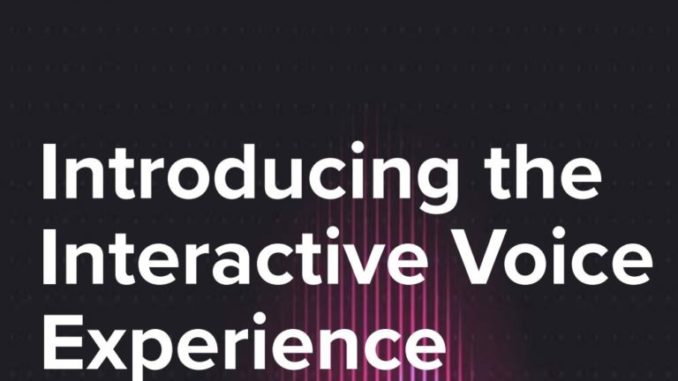
30-second summary:
An interactive voice experience leverages voice enabled devices like smart speakers, voice apps, and mobile chatbots to engage with consumers using voice technology
Smart speakers and other smart home products are owned by more than 55% of US adults. Smart speaker owners comprise about 90 million
ReadSpeaker AI is a leading text-to-speech provider that works with brands like Honda to develop branded TTS voices for an interactive voice experience. Their newly published guide includes a checklist to help businesses plan, design, and execute a compelling voice experience
Download the free guide, Introducing the Interactive Voice Experience, from ClickZ.
Smart speakers, mobile chatbots, speaker apps, and smart mirrors are examples of voice-first technologies that enable an interactive voice experience. Brands are using interactive voice in innovative and engaging ways that improve customer experience and help brands engage with customers.
ReadSpeaker AI, a leading text-to-speech (TTS) provider, writes, “Voice-enabled smart devices take us closer than ever to a world of ubiquitous computing, with hidden computers sewn seamlessly into our lived experience.”
ReadSpeaker AI works with businesses to create immersive conversational experiences using voice technology. Their new guide, Introducing the Interactive Voice Experience, includes key industry facts and statistics about the Internet of Voice (IoV) with specifics on how brands can design a strong voice experience.
Below, we’ve summarized some key points from the ReadSpeaker AI guide. The full guide contains a comprehensive three-step voice experience design checklist.
Content created in partnership with ReadSpeaker AI.
What is an interactive voice experience?
An interactive voice experience is any interaction that uses voice-first technology across a variety of voice “channels” such as smart speakers, mobile chatbots, and IoT-enabled devices to facilitate conversational brand engagement.
Readspeaker AI writes, “Together, these voice channels (and others) make up a distinct digital ecosystem called the Internet of Voice.”
Major League Baseball’s integration with Google Assistant which allows baseball fans to ask about schedules, stats, scores, and other team-related issues is one example of an interactive voice experience. Another is Reebok’s Cardi B sneaker drop which was promoted via sweepstakes that ran exclusively with Amazon Alexa and Google Voice. Reebok allowed entrants to join the contest, check their status, and claim their prize using voice-only technology.
Experiences like these take advantage of the growing IoV trend that has businesses increasingly leveraging smart speakers and other voice-first technologies to reach consumers through IoV channels.
Voice, as a channel, is growing rapidly. Over 55% of US adults use a smart device which includes smart speakers and smart home products. 45 million smart speaker owners use their devices every day and 70 million use them at least once a month. The most popular rooms for smart speakers are the bedroom and kitchen, immersing voice technology with consumers’ daily activities.
Building a solid voice experience
Voice technology is readily accessible to consumers in their homes and on their mobile devices, providing unique customer engagement opportunities for brands who want to reach their customers through voice-enabled channels.
ReadSpeaker AI’s three-step checklist to building an engaging voice experience covers the who, how, and what of designing a seamless voice experience. The checklist is segmented into three parts:
The People: This list helps you identify who you need to involve, from a leadership perspective, to create and launch a voice experience initiative for your brand. From CX experts to IT and digital gurus, it covers all the bases. There’s also a list of technology partners you’ll need to engage with if you don’t have all the technical expertise you need in-house.
The Plan: This very comprehensive list walks you through the nitty-gritty of creating your voice experience and answers the question “how will my voice experience function?” From establishing clear goals to educating your team to committing to a single approach, the items on this list will help you come away with a concrete plan of action.
The Tech: The final step to designing your voice experience comes down to the tech. This list enables you to move from planning to execution by identifying what’s needed in the development stage of your voice initiative.
Writes ReadSpeaker AI, “Voice technology leans heavily on artificial intelligence, combining natural language understanding with neural TTS, synthetic voices developed by deep neural networks (DNN). But most of that operates behind the scenes.”
The guide expands on each step in the checklist and provides clear direction for companies ready to delve into creating a compelling voice experience for their customers.
The importance of measurement
As with any new initiative, it’s important to set expectations and have a plan for measuring results for your voice experience. ReadSpeaker AI notes that traditional ROI metrics are difficult to measure with voice.
Soft returns such as brand lift, brand affinity, and improved customer engagement—all of which can be linked to increased profit—are more appropriate metrics. Writes ReadSpeaker AI, “More engaged customers are 23% more profitable than a casual buyer.”
For the full checklist that covers how to build a brand experience from conceptualization to launch, download a free copy of ReadSpeaker AI’s guide here.
The post How to create a seamless interactive voice experience appeared first on ClickZ.
Source: ClickZ
Link: How to create a seamless interactive voice experience


